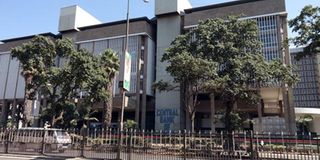Cost of credit may rise as delay in release of county funds hits banks

The Central Bank of Kenya building in Nairobi on June 2, 2014. In the week ending August 6, the Central Bank injected Sh23 billion into the market to ease pressure on the inter-bank rate after it rose for the fourth consecutive week. FILE PHOTO | SALATON NJAU |
What you need to know:
- The inter-bank rate has risen for the fifth week in a row to 11.58 per cent at the end of July 13.
- In the week ending August 6, the Central Bank injected Sh23 billion into the market to ease pressure on the rate.
The delay in the releasing money to ministries and to counties has increased the rate at which commercial banks lend to each other for the fifth consecutive week.
In a move likely to push up the overall cost of credit to consumers, the inter-bank rate has risen for the fifth week in a row to 11.58 per cent at the end of August, compared with 7.21 per cent in the week ending June 3.
Commercial bank analysts blame the trend on delays in sending money to counties, government ministries, agencies and departments.
“The Central Government is not spending. Funds have not been sent to ministries and the counties. This has caused a squeezing in liquidity in the market,” National Bank of Kenya’s head of treasury Solomon Alubala told the Nation by phone.
Payment of taxes to the government by corporates also caused reduced cash flows, which has led to the tightening of liquidity in the market.
In the week ending August 6, the Central Bank injected Sh23 billion into the market to ease pressure on the rate after it rose for the fourth consecutive week.
'TIGHTNESS IN LIQUIDITY'
Banks have, however, continued to sell cash to their counterparts at higher rates, with the costs expected to be passed on to consumers.
“We have continued to see a tightness in liquidity in the overnight market but the government is expected to release money for counties for this financial year,” Commercial Bank of Africa’s head of treasury Duncan Kinuthia said.
Smaller banks which have limited branch network often resort to the inter-bank market to borrow money, mostly from the bigger banks that have wide branch networks that enable them to mobilise cheap deposits from the public.
Analysts, however, say the situation is affecting all the banks, given that the government is yet to disburse funds to ministries and counties for onward spending.
In the week ending July 30, the rate stood at a single digit level of 8.54 per cent. The rate stood at 7.54 per cent in the period ending July 23, up from 7.21 per cent in the week ending June 3.
The increasing rate at which banks lend to each other has also seen the number of deals in the period decline, and so has the amount of money transacted.
At 11.58 per cent, the volume of money lent out stood at only Sh13 billion, compared with Sh24.9 billion lent out four weeks earlier.
“If the situation persists, banks will have to pass on the cost to consumer,” Mr Alubala said.





